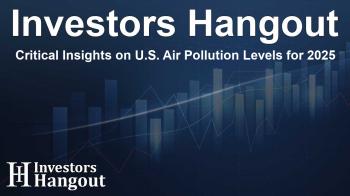Critical Insights on U.S. Air Pollution Levels for 2025

New Findings on Air Quality in the United States
The recently released report from the American Lung Association sheds light on a concerning reality: nearly half of the U.S. population is exposed to unhealthy air pollution levels. This alarming statistic arises from the annual "State of the Air" report, which details air quality data and its significant ramifications on health.
Understanding the Scope of Air Pollution
The report indicates that approximately 156 million Americans find themselves living in areas that have failed to meet acceptable safety standards for air quality. In particular, 25 million more individuals than in previous years are breathing air marked by concerning levels of ozone and particulate matter. This growing trend highlights not only environmental challenges but also the increasing health risks that accompany compromised air quality.
Health Implications for Communities
Air pollution does not discriminate; it affects families across various demographics. Children are particularly vulnerable, facing increased asthma incidents due to poor air quality. Adults working outdoors also report more frequent health issues, including respiratory conditions. In fact, the report notes a correlation between polluted air and adverse outcomes like low birth weight in infants, thereby emphasizing the urgent need for action to safeguard public health.
Key Findings from the Report
Several critical findings surfaced from the report's extensive analysis. Notably, individuals of color are disproportionately affected, with statistics showing they are more than twice as likely as white individuals to reside in communities facing significant air quality challenges. Additionally, Hispanic communities experience an even more striking disparity, being nearly three times more likely to encounter areas with failing pollution grades.
The Elephant in the Room: Policy Impacts
Politics and environmental standards intersect at critical points affecting air quality. The report outlines a discouraging trend; federal efforts aimed at improving air quality are facing significant rollbacks. Funding cuts and restructuring within vital organizations such as the Environmental Protection Agency (EPA) dilute their ability to protect and restore clean air. Without sufficient support, communities continue to grapple with the adverse effects of heightened pollution.
Spotlight on Particle Pollution
Particulate matter, also known as PM2.5, emerged as a focal point in this year's report. These tiny particles can be particularly harmful, originating from sources like wildfires, industrial activities, and vehicular emissions. The findings show that 77.2 million Americans currently reside in areas that encounter excessive short-term spikes in particle pollution, marking a concerning trend for public health and environmental safety.
Health Risks Associated with Ozone
Ground-level ozone, often referred to as smog, poses serious health threats. Exposure can lead to respiratory distress, exacerbating existing conditions like asthma. Moreover, the increasing temperatures, driven by climate change, complicate efforts to manage and reduce ozone levels. The report highlights the fact that over 125 million Americans now live in regions where ozone pollution exceeds acceptable guidelines.
The Most Affected Cities
Identifying the cities grappling with the worst air quality provides insight into regional challenges. Areas such as Bakersfield, Visalia, and Los Angeles are consistently highlighted for their elevated pollution levels. The ongoing issues in these metropolitan centers illustrate systemic environmental injustices that need immediate attention.
Communities Making Progress
Interestingly, while the report paints a somber picture of air quality across the U.S., it also spotlights communities achieving substantial improvements. Cities like Bangor, Maine, and San Juan, Puerto Rico, have made significant strides in ensuring cleaner air. Their success stories stand as examples of what dedicated efforts can accomplish and underscore the importance of continued vigilance and investment in air quality initiatives.
Concluding Thoughts
The "State of the Air" report serves as a call-to-action for individuals and organizations alike. It underscores the critical need for collective advocacy to support the EPA and push for sustainable solutions to air quality issues. Ensuring clean air is not merely a matter of regulatory compliance; it is a vital aspect of safeguarding public health.
Frequently Asked Questions
What is the main finding of the 2025 report on air pollution?
The report indicates that nearly half of the U.S. population is living in areas with unhealthy air pollution levels.
How has the air quality changed since last year?
Approximately 25 million more people are now exposed to unhealthy levels of air pollution compared to last year.
What health issues are associated with poor air quality?
Poor air quality can lead to health problems such as asthma attacks, heart conditions, and adverse pregnancy outcomes.
Which communities are most affected by air pollution?
Communities of color are disproportionately affected, with individuals in these demographics facing higher pollution levels than their white counterparts.
What can individuals do to help improve air quality?
Individuals can advocate for stronger environmental protections, support clean air initiatives, and reduce personal contributions to pollution.
About The Author
Contact Evelyn Baker privately here. Or send an email with ATTN: Evelyn Baker as the subject to contact@investorshangout.com.
About Investors Hangout
Investors Hangout is a leading online stock forum for financial discussion and learning, offering a wide range of free tools and resources. It draws in traders of all levels, who exchange market knowledge, investigate trading tactics, and keep an eye on industry developments in real time. Featuring financial articles, stock message boards, quotes, charts, company profiles, and live news updates. Through cooperative learning and a wealth of informational resources, it helps users from novices creating their first portfolios to experts honing their techniques. Join Investors Hangout today: https://investorshangout.com/
The content of this article is based on factual, publicly available information and does not represent legal, financial, or investment advice. Investors Hangout does not offer financial advice, and the author is not a licensed financial advisor. Consult a qualified advisor before making any financial or investment decisions based on this article. This article should not be considered advice to purchase, sell, or hold any securities or other investments. If any of the material provided here is inaccurate, please contact us for corrections.

